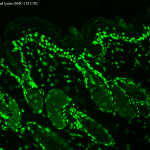1

Anti-Acetylated Lysine (monoclonal, clone 7F8)
AS10 707-100 | Clonality: monoclonal | Host: Mouse | Reactivity: acetylated lysine
- Product Info
-
Immunogen: acetylated KLH
Sub class: IgG1 Host: Mouse Clonality: Monoclonal Purity: Total IgG fraction. Protein G purified. Format: Liquid Quantity: 100 µl Storage: Store lyophilized/reconstituted at -20°C; once reconstituted make aliquots to avoid repeated freeze-thaw cycles. Please remember to spin the tubes briefly prior to opening them to avoid any losses that might occur from material adhering to the cap or sides of the tube. Tested applications: ELISA (ELISA), Immunocytochmistry/Immunofluorescence (ICC/IF), Immunohistochemistry (IHC), Immunoprecipitation (IP), Western blot (WB) Recommended dilution: 1 : 100 (IHC), 1 : 1000 (WB) - Reactivity
-
Confirmed reactivity: Bovine, avian Predicted reactivity: Higher plants Not reactive in: No confirmed exceptions from predicted reactivity are currently known - Additional Information
-
Additional information: Protein G purified IgG2B in PBS, pH 7,4 with 0,09 % sodium azide and 50 % glycerol at concentration 1 mg/mlantibody detects Proteins containing acetylated lysine residues in ELISA and WBs, Does not detect non-acetylated lysine residues Additional information (application): 1 µg of this antibody is sufficient to detect acetylated chicken erythrocyte histones (sodium butyrate-treated) using 20 µg total protein and ECL detection system
- Background
-
Background: Post-translational modifications of proteins play critical roles in the regulation and function of many known biological processes. Proteins can be post-translationally modified in many different ways, and a common posttranscriptional modification of Lysine involves acetylation (1). The conserved amino-terminal domains of the four core histones (H2A, H2B, H3 and H4) contain lysines that are acetylated by histone acetyltransferases (HATs) and deacetylated by histone deacetylases (HDACs) (2). Protein posttranslational reversible lysine Nε-acetylation and deacetylation have been recognized as an emerging intracellular signaling mechanism that plays critical roles in regulating gene transcription, cell-cycle progression, apoptosis, DNA repair, and cytoskeletal organization (3).
- Product Citations
-
Selected references: Vigushin & Coombes (2004). Targeted histone deacetylase inhibition for cancer therapy. Curr. Cancer Drug Targets 4: 205-218.
- Protocols
-
Agrisera Western Blot protocol and video tutorials
Protocols to work with plant and algal protein extracts
Agrisera Educational Posters Collection - Reviews:
-
Katarzyna Niedojad?o | 2012-04-18High quality of products.



